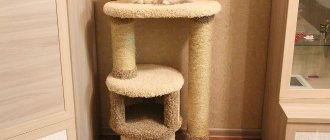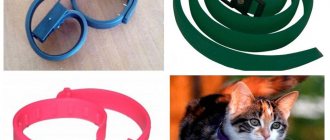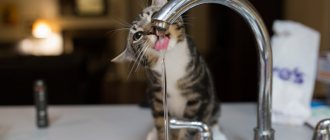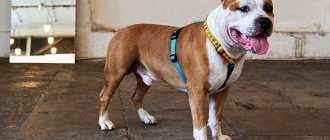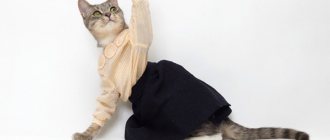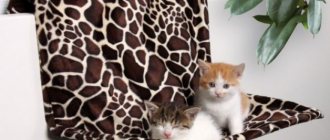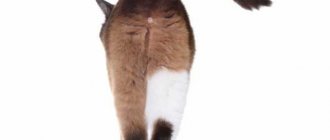The natural reflex of cats to lick their wounds in some situations harms them. Although this unique method of disinfection helps animals survive in the wild, it is not suitable for pets. There are more effective methods for disinfecting and healing wounds. But measures must be taken to prevent scratching and biting, which interfere with recovery. If you can protect a dog with a muzzle, then a veterinary collar will help a cat.
What is a protective collar for a cat?
A cat collar is usually referred to as a cone-shaped design. Other names are simpler - cone or cap. The design is made of durable material, narrowed on one side and larger in diameter on the other. This accessory is a popular tool in animal therapy using barrier structures.
A cat in protection will not be able to scratch unhealed wounds
The cap is used to protect and restrict access of a kitten or adult cat to areas of the body in the following cases:
- rehabilitation after castration;
- surgical interventions;
- processing wool with chemicals;
- recovery after abdominal surgery.
In all of these situations, the animal should not have even the slightest chance of scratching or gnawing wounds, or licking fur treated with chemicals. The main purpose of the barrier is to protect the animal and prevent it from harming itself.
In what cases is protection not needed?
House for a cat: options for how to make it yourself
Freedom-loving animals have difficulty accepting a new wardrobe item. Therefore, if the pet cannot calm down, the veterinary cap will have to be removed.
There are times when completely getting rid of an accessory that is unpleasant for an animal is simply dangerous for its health. In such cases, it is necessary to replace the barrier structure with a bandage that is tied on the back. Animals perceive such a unique T-shirt more calmly.
A cat wearing a bandage feels more confident
Braided collar pattern
For advanced needlewomen, it will not be difficult to knit or crochet a collar or weave it using the macrame technique. Embroidery would also be appropriate here. In addition, the pattern can be completely different. It could even be the name of your pet, place of residence, or a contact phone number that can be used in the event of a loss of the animal.
You see in the photo a DIY cat collar using the macrame technique, which is used for weaving bracelets and belts.
The technology of weaving baubles is also popular. This accessory will undoubtedly please your ward.
What to look for when choosing
A veterinary accessory significantly complicates the life of an animal, so its choice should be taken with full responsibility. Choosing a veterinary collar for a cat is quite difficult, since you need to take into account many nuances.
Do-it-yourself collar for a dog after surgery
The part of the product adjacent to the neck should be soft, ideally covered with fabric. The height of the cone should not be too high so as not to interfere with the view. However, a low one will not work, otherwise it will lose its functionality.
Additional Information! Size is the most important criterion. The kitten should not remove the product easily. But it is worth considering that a narrow collar will put pressure on the neck. A product that holds its shape well is considered good.
Which material to choose?
The collar implies its constant use, that is, your pet will be wearing it all the time. Therefore, the choice of material must be taken seriously. First of all, it must be safe for the animal. Good for this:
- leather;
- thick fabric;
- ribbons;
- rubber bands.
If you want to use accessories to make a cat collar with your own hands, then when choosing them you need to be guided by the fact that they should be light and durable. You can use light metal, plastic or silicone.
The collar clasps should also be strong and secure. For this purpose, buttons, Velcro or strap fasteners will do.
Size chart of protective collars for cats - table
The big advantage of this category of veterinary product is that it can be selected in size according to the parameters of the animal. The following table will help you buy the right barrier cap:
How to make a house for a cat with your own hands: patterns
| Neck circumference (cm) | Collar height (cm) | Marking number |
| 22-25 | 7 | 7 |
| 22-25 | 10 | 10 |
| 28-33 | 12 | 12 |
| 31-38 | 15 | 15 |
| 38-44 | 20 | 20 |
| 44-50 | 25 | 25 |
| 47-57 | 30 | 30 |
This information is very helpful when purchasing a barrier for your furry friend.
The main thing is to take measurements of your pet correctly. For your information! A cat collar can be made from cardboard, plastic, fabric and other materials.
Each of them has its own pros and cons.
Why does a cat need a collar, leash or harness?
Even the most phlegmatic domestic cats are happy with the new experiences that a walk gives. And if your pet has an active temperament or has lived on the street in the past, he may feel sad, sitting in the apartment all day long. In order to make walking with your cat safe and comfortable, special devices come to the rescue: a collar, a leash and a harness.
Walks give cats many new experiences
Collar
Some owners purchase anti-parasitic collars for their cats, which the pets even wear around the house. But for a walk you need a more reliable collar with a strong clasp.
If your cat walks, as the saying goes, on its own, you need to choose a comfortable collar for it that will not allow the animal to get caught on protruding dangerous objects and will not fly off during active movements. In addition, the collar must have a mount for an address book on which you can write the cat’s name, your phone number or address. If the pet gets lost or gets into trouble, the people who find it will be able to return the poor thing home. When deciding to walk an animal on its own, you need to be aware that it is unsafe.
The pet's collar must have a tag with the owner's number on it.
An option in which you can not worry about your pet, but at the same time give him the joy of a walk, is to use a collar in tandem with a leash.
Leash
As mentioned above, a leash is the key to a safe walk with a cat. It is best to opt for a long but strong leash. A chain, unlike dogs, is not suitable for cats - it is heavy and can scare your furry or cause him pain.
The cat's leash should be soft and light
And, of course, even when walking on a leash, put a tag with contacts on your cat’s collar - just in case.
Harness
What should you do if your mustachioed pet refuses to walk on a leash and doesn’t like the collar? It doesn’t matter, you can replace these devices with a harness. It looks like an interweaving of wide straps that cover the chest, part of the back and paws.
As a rule, this object irritates cats less and causes less pain when moving, because the throat is a sensitive part of the body of any living creature. When wearing a harness, most of the load falls on the chest, not the neck. And in case of danger (an approaching dog, falling into a hole), it is much easier to grab the pet by the back strap of the harness than to pull the leash.
Most cats enjoy being walked on a harness rather than on a leash.
My cats (both those who came into the house as babies and former street residents with experience) love walks in the fresh air. However, they absolutely do not like harnesses. Animals fall on their stomachs or sides, refuse to move and even lose interest in walking. The situation is completely different when pets are wearing a collar and an ordinary leash. Cats behave appropriately, move along the ground, sniff the grass, albeit with some caution. Perhaps it's because my cats live with dogs and see them walking on leashes. I don’t see any other reason for preferring this accessory to a harness. If it were not for the silent but expressive protest of the cats, I would prefer to walk them on a harness.
How to make a fabric collar
When it is not possible to buy a barrier structure, it can be made from a comfortable collar and scrap materials that you have at home. There is nothing complicated about this. It is enough to follow the step-by-step instructions, and then everyone will be able to cope with this task.
Made from soft fabric
It is important to take care of the animal's comfort. A veterinary cap made of fabric is considered the most convenient. When wearing it on the neck there is practically no load. It does not bother the cat, adapting well to its body.
Such a cone is sewn from natural fabrics such as linen or cotton. The pattern is outlined on the fabric and the blank is cut out, and then all the parts are sewn together.
Important! Fabric products do not hold their shape well. To make them stronger and more stable, plastic or plastic stands are used. Or you can simply fold the fabric in several layers.
The fabric collar does not put pressure on the pet's neck
Made from thick fabric
The product is made according to the same principle as in the previous version. Just choose a denser fabric - non-woven fabric, felt. Dense material holds its shape better, so one layer will be enough to make a high-quality barrier.
Feature of the pattern
When making a protective cap for a cat yourself, you will have to prepare a pattern. It looks like a half ring.
The collar should not interfere with the pet’s view, so before starting work it is necessary to measure the circumference of the neck, which will correspond to the length of the inner line of the semi-ring. The length of the pattern should be with a margin of 2 cm.
The collar pattern is very simple
How to choose a size
Whatever model the owner prefers, it is necessary first of all to take care of the correct choice of protective device according to the size of the pet. In this matter, they are guided by the width of the protective field. Sizes No. 10 and 12 correspond to a width of 10.5 and 12 cm and are suitable for dogs of dwarf and miniature breeds.
A protective structure with size No. 15 should be chosen for a medium-sized pet with a neck circumference of no more than 15 cm. For dogs of large breeds, it is necessary to purchase protective products in sizes No. 20 and No. 25.
Collar Size Chart
Elizabethan animal collars are usually sold unassembled for ease of transportation. Assembling the collar is easy, following the instructions. As a rule, the structures are given the appearance of a cone and secured with special clamps. If the size is chosen correctly, the protective cone protrudes slightly beyond the boundaries of the dog's head.
A well-chosen protective design does not limit the pet’s view, does not hinder its movement, and does not interfere with the intake of food and water.
DIY Elizabethan cat collar made from cardboard
This design provides assistance during the rehabilitation of pets after operations. The main thing to consider is that the collar should be comfortable.
If it is not possible to buy a suitable accessory, then the most affordable option would be a homemade cardboard collar. You can use any cardboard box from which 2 semicircles are cut out, the inner diameter of which should be the length of the collar. Then use tape to connect both parts.
The collar is attached to the collar. In order not to spoil it, you need to put a cover on the collar and sew a cone-shaped protection to the cover.
Spiked Collar
In this option, a silicone wrist bracelet is used as the basis for the collar. This is convenient because you don’t have to worry about attaching fasteners. In addition, silicone stretches well. But you should keep in mind that such an accessory is not suitable for large and well-fed cats.
So, we take the decorative spikes and, using a needle and thread, firmly grab them to the bracelet. You can leave the interval between them as you wish, but we suggest approximately 2-3 cm. The brutal accessory for your cat is ready.
There are many more options that you can use when making a cat collar with your own hands. For example, you can use the Shambhala technique and weave a collar from strong threads or thin strips of leather.
How to make a cat collar with your own hands from a plastic bottle
The main condition for high-quality production of a bottle collar is the correct size. In most cases, a two-liter bottle will do. Manufacturing process:
- On the neck of the bottle, select a place with a diameter suitable for the cat’s neck.
- From this line the height of the collar is measured and all excess is cut off.
- A vertical cut is made and holes for lacing are made on each side.
- The holes are treated so that they do not injure the animal. For example, you can heat them with a candle so that the edges melt and become less sharp.
- Pull the lace through the holes.
- Improve the quality of the accessory by attaching a case with loops for the collar.
Important! The animal should be comfortable. Therefore, you need to regularly check that the cone does not press or rub your neck.
A plastic bottle as a collar is the most economical option
Other options for homemade cat collars
There are many other options for making safety collars. One of the most popular and simple models is a foam cone. A ring is cut out of a sheet of foam rubber. The thickness of the ring should be no more than 2 cm and the diameter 30 cm.
You can also make your own cat collar from a plastic or paper plate. A circle is cut out in the center 1 cm larger than the diameter of the neck. The inside is glued with fabric to prevent injury from the sharp edge. The product is put on the cat and the incision site is sealed with tape.
Important! Homemade structures are more suitable for short-term restriction of movement, since they are not very durable.
Collar with medallion
This accessory option will be more expensive both in terms of finances and time. In order to make a DIY cat collar with a medallion, we will need:
- thick steel plate;
- blank for medallion;
- cores with letters or numbers (depending on the inscription);
- hammer;
- masking tape;
- a steel ring on which the medallion will hang;
- favorite cat collar;
- permanent marker (optional).
Here a ready-made collar is used, but the name medallion is made by hand. So, we fix the blank for the medallion with masking tape on the steel plate so that there is space left for the inscription.
Next we mint the inscription. After making sure that the inscription will fit in width on the medallion, we place the core with the middle element of the inscription in the center of the workpiece. We hit the core several times with a hammer. We do the same with the remaining letters.
You can write out the cat's name, residential address or mobile number. The inscription can also be made on both sides of the workpiece.
Next, we paint over the inscription with a permanent marker to make it easier to read. We drill a hole on the medallion with a thin drill, thread a ring through it and hang it on the collar. The collar with a name medallion for your fashionista is ready.
How to put on a collar
In some situations, protection is worn in the clinic. In all other cases, you will have to cope with this difficult task yourself.
The collar should fit in size and not press or hang around your neck. Before putting on the accessory, you need to calm the animal. If the cat starts to get nervous, you need to pet it, carry it in your arms, talk to it in a calm voice and then try to put on the accessory again.
Important! You need to periodically check how correctly the collar fits. After all, the pet may try to remove it and thereby move it so that it becomes uncomfortable. The distance between the barrier and the neck should be at least 1 cm.
How to put on a collar
What to do if the animal cannot get used to the collar
A cat owner may notice that his pet is taking off his protective collar, what should he do in this case? Most likely, an unreliable design was chosen that can be easily removed over the head or unfastened or torn.
Perhaps the product has sharp edges that rub the animal’s neck and cause irritation
. This assumption should be tested.
IMPORTANT!
Cats have a great sense of how people treat them. If, in addition to the inconvenient design, they also receive indifference from the owners, rehabilitation after injury or surgery will be difficult.
There are cats that will not be able to put up with a collar for a long time; you need to show maximum attention to your pet, pick it up more often, and calm it down. When it’s time for lunch, the “Spanish cow collar,” as it is sometimes called, needs to be removed and the cat should be fed something tasty.
Your cat may be irritated by certain types of collars, such as those made of plastic or opaque. If you change the design, the cat calms down and over time gets used to slight discomfort.
Wearing rules
Putting a collar on an animal is only a small part of the job. The owner must help him get used to the new wardrobe item. At first, it is removed before feeding.
When an animal undergoes a course of injection treatment and is given injections in the scruff of the neck, the accessory must be worn in such a way that the rough fastener does not rest on this place.
They also do periods of rest from the collar. For this purpose, the kitten is temporarily freed from the product, but so that it does not harm itself at this time, it is held in their arms.
Advice! If the pet strongly protests against the veterinary accessory, you need to periodically remove it, but then put it on again as soon as the animal has rested a little.
How long should you wear the collar?
Injuries, post-operative scars and skin diseases require caring and attentive treatment. The animal will try to lick its wounds, and if you allow it to do so, the healing process will be delayed. An infection may also occur, leading to serious complications.
On average, the rehabilitation period lasts from one to two weeks. But in each individual case the process takes place individually, because the animal’s recovery period depends on the state of health, age and its body. Attention and care for the kitten will quickly bring the animal back to normal. A comfortable rehabilitation period depends entirely on the efforts of the owner.
Table: advantages and disadvantages of protective devices
It is important for every caring owner to understand the benefits of protection and whether it can harm the pet. A protective collar, like any device, has its advantages and disadvantages. Having studied them, the owner will be able to understand that the benefits from it are much greater than the disadvantages.
It is enough to make a simple comparison:
| Disadvantages of a collar | Advantages of a collar |
| Animal discomfort | Durable and reliable |
| Discomfort when eating | Wide range of applications |
| Difficulty in selecting a model for large or small animals | Protects against wound infection |
| Clean cats cannot lick themselves while wearing this accessory. | Prevents the animal from hiding in a hard-to-reach place |
| Ability to cling to objects | Large selection of options in different price categories |
In barrier therapy, the protective collar for cats has proven its effectiveness in practice. It allows you to maintain good health during conservative treatment or in the postoperative period. A properly selected collar will allow the cat to recover comfortably and without harm to health.
Why do you need a collar?
Many cats do not walk outside, then the question arises: why does she need a collar? After all, this is not a dog. But not only those animals that go outside wear a collar. It all depends on the purpose of the collar.
Most cat collars are designed for beauty purposes and are used as accessories. Some may have contact information about the owners, so that if lost, kind people can find you and return your pet to you. This technique is often used by owners of purebred and expensive cats.
Another option is anti-parasite collars. They are worn by animals for medicinal or preventive purposes. Such collars are not made at home, but are purchased in specialized veterinary stores.
Therefore, making a cat collar with your own hands will differ depending on the purpose for which you will use this device.
